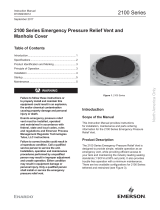
D-Series with HART Protocol Installation, Operation & Maintenance 502.969.8000
DEADBAND
INDICATION
Operation of the 4-20mA Current Position Transmitter
During run mode, the 4-20mA position transmitter will output 4-20mA for valve positions between and including the set points. In the rotary mode,
the module will provide an over or under travel correction if the valve position exceeds the high or low set point within +/-3% . In other words, the
output will be 4mA for +/-3% over and under travel on the low end and 20mA for +/-3% over and under travel on the high end. If the valve position
exceeds 3% of over travel, then values below 4mA or above 20mA will be output. In the linear mode, no under or over travel is compensated
for. The device can be set to either linear or rotary mode during calibration using the on board push button switch, or remotely using HART
communications.
Calibrating End Set Points Locally:
The 4-20 current transmitter can be used for any rotation range between 20 and 320 degrees**.
Option #1: +/- 3% Over and Under Travel at the Set End Points (Rotary):
1) As the shaft rotates, make sure the potentiometer is not rotating through its deadband area. The red dot located on the potentiometer should
not rotate past the area marked with red during the full rotation of the valve. If it does, reposition the shaft.
2) Apply power to unit (LED should be continuously on to indicate the unit has been calibrated or flashing the 4-1 code to indicate the unit has
not been calibrated)
3) Counter-clockwise calibration - Press the button greater than 0.5 seconds and less than 3 seconds if you are going to calibrate using a
counter-clockwise rotation from the 4mA position to the 20mA position. (LED will start flashing a 3-1 code indicating that calibration mode is
active and the unit is waiting to calibrate the 4ma position).
4) Clockwise calibration - Press the button greater than 3 seconds and less than 5.5 seconds if you are going to calibrate using a clockwise
rotation from the 4mA position to the 20mA position. (LED will start flashing a 3-2 code indicating that calibration mode is active and the unit
is waiting to calibrate the 4mA position).
5) Rotate valve to the desired position corresponding to 4mA. (This can be the open or closed position)
6) Press the button to capture the 4mA value (The LED will start flashing a 3-3 code indicating that the unit is waiting to calibrate the 20mA
position)
7) Rotate valve to the desired position corresponding to 20mA (This will be the position opposite of the position in step 3 or step 4)
8) Press the button to capture the 20mA value (The LED will turn on continuously)
Option #2: No Under and Over Travel at Set End Points (Full Linear):
1) As the shaft rotates, make sure the potentiometer is not rotating through its dead band area. The red dot located on the potentiometer should
not rotate past the area marked with red during the full rotation of the valve. If it does, reposition the shaft.
2) Apply power to unit (LED should be continuously on to indicate the unit has been calibrated or flashing the 4-1 code to indicate the unit has
not been calibrated)
3) Counter-clockwise calibration - Press the button greater than 5.5 seconds and less than 8 seconds if you are going to calibrate using a
counter-clockwise rotation from the 4mA position to the 20mA position. (LED will start flashing a 5-1 code indicating that calibration mode is
active and the unit is waiting to calibrate the 4mA position).
4) Clockwise calibration - Press the button greater than 8 seconds if you are going to calibrate using a clockwise rotation from the 4mA
position to the 20mA position. (LED will start flashing a 5-2 code indicating that calibration mode is active and the unit is waiting to calibrate
the 4mA position).
5) Rotate valve to the desired position corresponding to 4mA. (This can be the open or closed position)
6) Press the button to capture the 4mA value (The LED will start flashing a 3-3 code indicating that the unit is waiting to calibrate the 20mA
position)
7) Rotate valve to the desired position corresponding to 20mA (This will be the position opposite of the position in step 3 or step 4)
8) Press the button to capture the 20mA value (The LED will turn on continuously)
NOTE:**The potentiometer has been factory set for typical valve rotation ranges from 20 to 180 degrees in counter-clockwise rotation applications
from the 4mA position to the 20mA position and from valve rotation ranges from 20 to 90 degrees in clockwise rotation applications from the 4mA
position to the 20mA position. Please contact TopWorx for proper potentiometer set up for ranges greater than specified above.
NOTE: Schematics are
for illustration purposes
only. Refer to the wiring
diagram on your product
to determine actual pin
out location
PUSHBUTTON
LED LIGHT

























